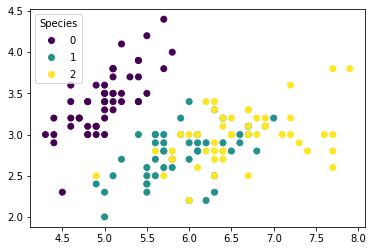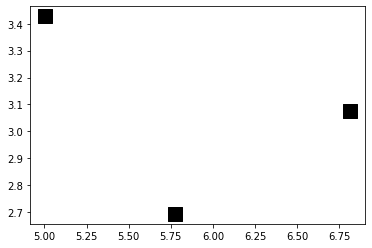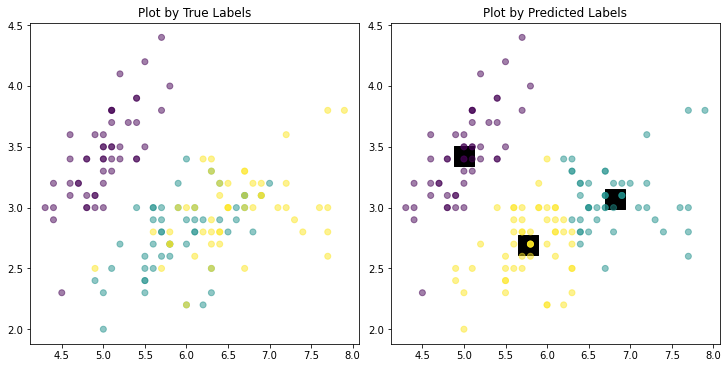K-means Clustering
Contents
11.1. K-means Clustering¶
So far, we have learned a lot of supervised learning algorithms (eg., Decision Tree, Random Forest), in which labelled or known outcomes are given. In contrast, unsupervised learning uses unlabeled data to discover patterns that help solve for clustering or association problems, and K-means clustering is one of the simplest and most popular unsupervised learning algorithms.
From wiki:
Given a set of observations \((\boldsymbol{x}_1, \boldsymbol{x}_2, \dots, \boldsymbol{x}_n)\), where each observation is a d-dimensional real vector, k-means clustering aims to partition the n observations into k (≤ n) sets \(\boldsymbol{S} = \{S_1, S_2, \dots, S_k\}\) so as to minimize the within-cluster sum of squares (WCSS) (i.e. variance). Formally, the objective is to find:
\[\begin{equation*} \underset{S}{\mathrm{argmin}} \sum_{i=1}^{k}\sum_{\boldsymbol{x}\in S_i} \left\|\boldsymbol{x}-\boldsymbol{\mu}_i \right\|^2 \end{equation*}\]where \(\boldsymbol{\mu}_i\) is the mean of points in \(S_i\).
11.1.1. Lloyd’s algorithm¶
Initialize \(\boldsymbol{\mu}_i\) randomly
Alternate:
assignment: \(S_i\) <- \(\underset{S}{\mathrm{argmin}} \sum_{i=1}^{k}\sum_{\boldsymbol{x}\in S_i} \left\|\boldsymbol{x}-\boldsymbol{\mu}_i \right\|^2\) for all i
update: \(\mu_i\) <- \(\frac{1}{|S_i|}\sum_{\boldsymbol{x}_j\in S_i}{\boldsymbol{x}_j}\)
When
iter = max_iteror when the assignments do not change, algorithm terminates
Source: https://en.wikipedia.org/wiki/K-means_clustering#Gaussian_mixture_model
11.1.2. Implementation¶
Like many other popular algorithms, K-means can also be implemented by importing the scikit-learn package
11.1.3. Iris data¶
import pandas as pd
import numpy as np
import matplotlib.pyplot as plt
from sklearn import datasets
iris = datasets.load_iris()
X = iris.data[:, :2] # we only take the first two features.
y = iris.target
We first plot the observations by their true species.
fig, ax = plt.subplots()
scatter = ax.scatter(X[:,0], X[:,1], c=y)
ax.legend(*scatter.legend_elements(),
loc="upper left", title="Species")
plt.show()

11.1.3.1. Training K-means¶
Now let’s pretend we do not know the true borough of each data point, and try to predict it with their longitude and latitude.
from sklearn.cluster import KMeans
Kmean = KMeans(n_clusters = 3)
Kmean.fit(X)
KMeans(n_clusters=3)
Several parameters can be modified in the algorithm, see https://scikit-learn.org/stable/modules/generated/sklearn.cluster.KMeans.html
11.1.3.2. Results¶
The predicted centroids can be obtained by Kmean.cluster_centers_.
print(Kmean.cluster_centers_)
fig = plt.figure()
plt.scatter(Kmean.cluster_centers_[:,0], Kmean.cluster_centers_[:,1], c="black", s=200, marker='s')
plt.show()
[[5.006 3.428 ]
[6.81276596 3.07446809]
[5.77358491 2.69245283]]

The trained labels can be obtained by Kmean.labels_, and now we can compare them to the true values.
fig, axs = plt.subplots(ncols=2, nrows=1, figsize=(10, 5),
constrained_layout=True)
axs[0].scatter(X[:,0], X[:,1], c = y, alpha = 0.5)
axs[0].set_title("Plot by True Labels")
axs[1].scatter(Kmean.cluster_centers_[:,0], Kmean.cluster_centers_[:,1],
marker = "s", c = "black", s = 400, alpha = 1) # plot predicted centroids
axs[1].scatter(X[:,0], X[:,1], c = Kmean.labels_, alpha = 0.5)
axs[1].set_title("Plot by Predicted Labels")
plt.show()

The algorithm seems to be good yet there are several “misclassified” data points, mainly in the two clusters that are more mixed (non-separable). This is reasonable since K-means only minimizes within-cluster variances (squared Euclidean distances).
11.1.3.3. Prediction¶
If we have some new data, we can use Kmean.predict to predict which cluster they belong to.
sample_test=np.array([[3, 4], [7, 4]])
Kmean.predict(sample_test)
array([0, 1], dtype=int32)
11.1.4. Comment¶
K-means is a powerful unsupervised clustering algorithm that can be easily understood and implemented, but there are still some disadvantages.
The algorithm is extremly sensitive to the choice of initial cluster centroids. In the above problem, we use default parameters
init='k-means++'andn_init = 10to avoid local minimums. See https://www.analyticsvidhya.com/blog/2019/08/comprehensive-guide-k-means-clustering/#h2_9.The number K is another important parameter in the algorithm. In our problem we just use
k=3because there are 3 species in the data set, but in pratice this can be more complicated. A plot of “elbow curve” can be used to determine K. See https://www.analyticsvidhya.com/blog/2019/08/comprehensive-guide-k-means-clustering/#h2_9.In cases where the underlying clusters are non-spherical, K-means will perform badly. In such cases, the algorithms can be run with “kernel methods”. See https://medium.com/udemy-engineering/understanding-k-means-clustering-and-kernel-methods-afad4eec3c11